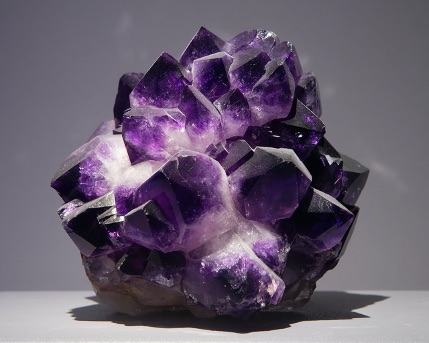
To Egyptians and ancient Greeks, amethysts were as precious as diamonds, rubies, and sapphires.
The stone was thought to cool tempers and prevent drunkenness, so it was cut into jewelry for wise kings and crafted into wine goblets for those who hoped to stay sober.
In the Middle Ages, it adorned the rings of religious leaders and the scepters of royalty.
Since then, huge finds in many places, especially Brazil and Uruguay, have made amethyst plentiful and affordable.
And that’s good, because this brilliant purple gem is now available to everyone and is still just as striking.
Especially when you consider that amethyst is just quartz with a few special qualities. It has trace amounts of iron, only a few parts per million.
These would normally be invisible, but when exposed to gamma rays, they make the quartz turn purple—into amethyst.
It doesn’t take a lot of radiation; it’s naturally occurring in other rocks found where amethyst crystals grow, and not nearly enough to be harmful to humans.
Amethyst’s color can change when exposed to other kinds or radiation. Enough UV radiation from sunlight will fade it to lilac or gray.
And it can change color when heated, turning light green, yellow, or brown… though another dose of the right radiation can bring back its purple hue.
Amethyst is the February birthstone, so if you know anyone born in this month, try giving them a birthday gift that was once the stone of sober kings.
Background
Synopsis: There are many legends about amethyst, from its origins to how it was used to signal lovers about safe haven in difficult times. The deep purple gemstone has been prized as a symbol of power, love, and intelligence over the ages. February’s birthstone was once one of the most valuable of gems, but today we know it is simply a beautiful variety of quartz crystal with an added bit of iron and radioactivity.
- In ancient times, the color purple signified power and royalty because it was very difficult to make.
- Tyrian purple pigment is made from mucus secreted by certain Mediterranean and Atlantic Murex sea snails.
- The yellow mucus oxidizes to reddish purple in bright sunlight along shorelines. Each gastropod produces only a drop of dye, so thousands were required to color fabric, rendering purple fabric very expensive and rare.
- In 1904, a synthetic coal tar dye was developed, reducing the cost of purple dye.
- The historical romance around amethyst was derived from both its coveted deep purple color and its rareness.
- Amethyst has been valued as a gemstone for thousands of years. It was one of the five traditional cardinal gemstones considered precious above all others, along with diamond, ruby, sapphire, and emerald.
- Some historians suggest that at one time, amethyst was the most valuable of all the cardinal gems because it was the color of kings, nobles, priests, and magistrates.
- In the 1800s, discoveries of multiple large amethyst mines in Brazil provided such a large supply that the gem was no longer rare, making it affordable.
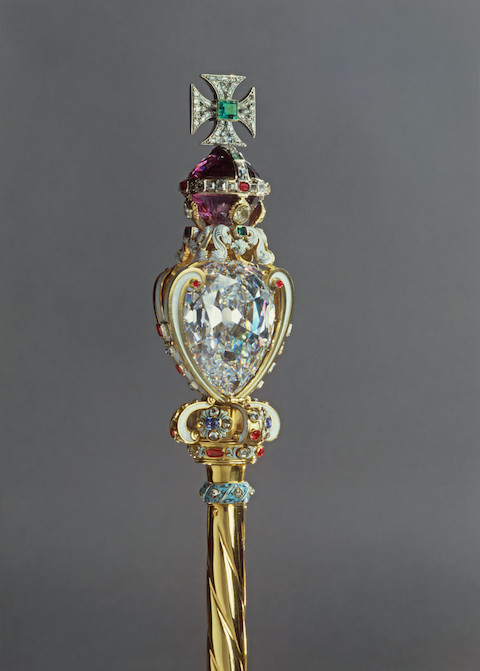
- Egyptian pharaohs favored amethyst from Nubia, a region at the confluence of the Blue Nile and White Nile, for personal adornment as long ago as 3100 BC.
- Egyptians thought it protected them against witchcraft and feelings of guilt and fear. It has been found in many royal tombs.
- The boy king Tutankhamen was entombed with a bracelet featuring a large amethyst scarab, and Queen Mereret was buried with amethyst heart scarabs and an anklet with gold and amethyst beads.
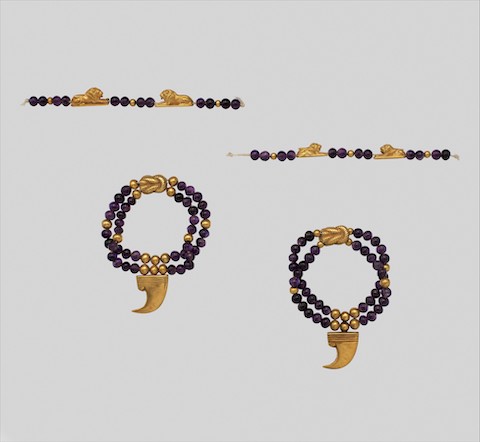
- Ancient Greeks thought amethyst looked like the color of wine, so they called it amethystos, which translates to “not drunken.” Greek jewelry and goblets were carved from the stone with the hope it would ward off drunkenness.
- In the 1500s, the French poet Remy Belleau wrote a poem invoking a romantic myth about Bacchus and the origin of amethyst, forever linking the gemstone to love and passion.
- Bacchus is the Roman equivalent of Dionysus, the Greek god of agriculture, wine, and fertility. Diana is the Roman equivalent of Artemis, the Greek goddess of animals and the hunt.
- In Belleau’s poem “L’Amethyste, ou les Amours de Bacchus et d'Amethyste,” the Roman god Bacchus pursues a young maiden named Amethyste, who prays to the goddess Diana to save her chastity from his advances. Diana protects her by turning her into a white stone, and a humbled Bacchus pours wine over the stone, rendering it purple.
- In a Greek version of the story, Dionysus, who has been insulted by a mortal, swears to slay the next mortal who crosses his path by creating ferocious tigers. A maiden on the way to pay tribute to Artemis is the next person along the path, so Artemis turns her into a statue of quartz to protect her from the attack. Dionysus weeps remorseful tears of wine when he sees the beautiful statue, turning it into the purple gemstone.
- In the 1500s, the French poet Remy Belleau wrote a poem invoking a romantic myth about Bacchus and the origin of amethyst, forever linking the gemstone to love and passion.
- In addition to love and sobriety, amethyst was thought to bring its wearer courage and emotional stability while enhancing cooperation and flexibility, improving sleep, and providing good dreams.
- Classical texts say the Greek Titan Rhea presented Dionysus with amethyst to preserve his sanity.
- The ancient Chinese art of feng shui uses amethyst to drive away the hazards of life and to clear negative energy.
- Tibetans make prayer beads from amethyst and consider the stone sacred to the Buddha.
- The Bible’s book of Exodus describes amethyst as one of the 12 stones of Aaron’s Breastplate representing the tribes of Israel. The Hebrew word for the stone, Ahlamah, means “dream stone.”
- Medieval Europeans believed amethysts keep people calm and heal injuries, so soldiers would often wear amulets into battle and were even buried with them.
- In the late 1400s, Italian Renaissance artist and scientist Leonardo da Vinci wrote that amethyst sharpens intelligence and decreases harmful thoughts.
- Amethyst is also a symbol of devotion. Christian bishops wear amethyst rings on the middle finger of their right hand to signify that they are wed to the church.
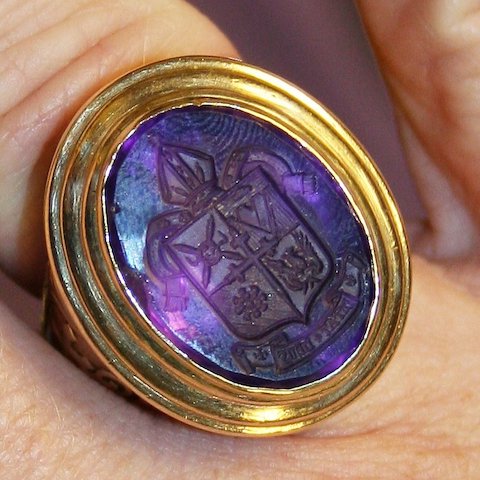
- In the 3rd century AD, a Christian priest known as Valentine was said to have worn an amethyst ring with the image of Cupid engraved in it. He may have been a bishop. There are multiple stories and multiple Valentines.
- At the time, Roman soldiers were prohibited by the emperor from entering into Christian marriages. Valentine would perform Christian weddings for soldiers in secret, so the soldiers would look for the priest with the amethyst ring and ask him to marry them.
- Valentine was beheaded for these acts on February 14, ca. 270 AD. He was later sainted, and February 14 became St. Valentine’s Day.
- Around the1370’s, Geoffrey Chaucer—who was the author of The Canterbury Tales—wrote a poem that referred to St. Valentine’s Day as a day to commemorate courtly love “when every bird comes there to choose his mate.”
- Ever since then, Valentine’s Day has been celebrated as a day for lovers.
- Amethyst ranges from pale lilac to deep royal violet.
- Just like ruby and sapphire are varieties of corundum, and emerald and aquamarine are varieties of beryl, amethyst is a variety of one of the most common minerals on earth: quartz.
- Amethyst forms in cavities or fissures where there is hot (120–480°F, 50–250°C) silica-enriched water, trace amounts (10–100 ppm) of ferric iron (Fe3+), and gamma radiation.
- These conditions occur in basaltic lava tubes, igneous hydrothermal deposits, and metamorphic fissures.
- As the hot fluids deposit crystals in the hollow crevices of rock, they grow from base to tip. Because the tips form later in the sequence, when more iron is concentrated in the fluids, the tips are often a deeper purple than the bases of the crystals.
- Radiation causes the trace amounts of iron to lose an electron, creating the purple color. Many igneous rocks include radioactive elements from the uranium-thorium decay series that produce enough radioactivity to turn the traces of iron purple.
- Like quartz, amethyst grows in six-sided prisms with a pyramidal end. It doesn’t cleave along a straight plane but rather it fractures conchoidally, so gem cutters have to be very careful with it.
- Natural amethyst can be dichroic, looking reddish violet when viewed from one direction and bluish violet from the other.
- Natural amethysts are often zoned during crystallization, creating a striped appearance between deeper and lighter coloration parallel to the crystal faces.
- Amethyst’s sister gem, citrine, incorporates a different oxidation state of iron that gives it its yellow-green color. Natural varieties of citrine also exhibit zoning stripes.
- Depending on the type of radiation, the effect is different. Amethyst left in UV light like sunlight will fade, and heat will cause it to fade or turn gray or yellow, like citrine. But exposure to X-rays may restore its purple color.
- Synthetic amethyst can be produced by hydrothermal growth inside a high-pressure autoclave.
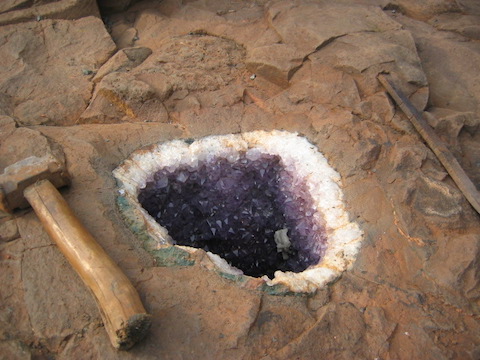
- Brazil is the largest producer of amethyst. Mines in the states of Minas Gerais, Rio Grande do Sul, Maraba, and Bahia produce the stones from cavities in basalt flows.
- Amethyst deposits are also found in Uruguay, Zambia, Bolivia, Siberia, Sri Lanka, India, Canada, and the United States.
- In the United States, Arizona’s Four Peaks Mine is the only remaining commercial amethyst mine, producing a distinctive reddish-purple colored amethyst. Some of the Spanish crown jewels may have been mined at this deposit.

